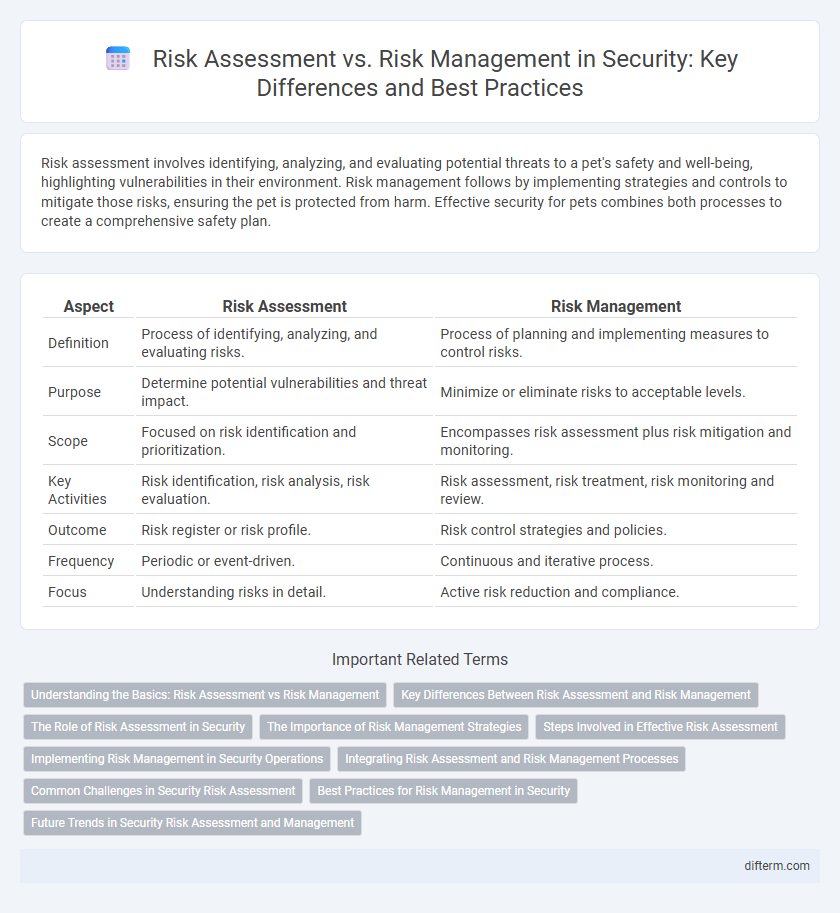Risk assessment involves identifying, analyzing, and evaluating potential threats to a pet's safety and well-being, highlighting vulnerabilities in their environment. Risk management follows by implementing strategies and controls to mitigate those risks, ensuring the pet is protected from harm. Effective security for pets combines both processes to create a comprehensive safety plan.
Table of Comparison
| Aspect | Risk Assessment | Risk Management |
|---|---|---|
| Definition | Process of identifying, analyzing, and evaluating risks. | Process of planning and implementing measures to control risks. |
| Purpose | Determine potential vulnerabilities and threat impact. | Minimize or eliminate risks to acceptable levels. |
| Scope | Focused on risk identification and prioritization. | Encompasses risk assessment plus risk mitigation and monitoring. |
| Key Activities | Risk identification, risk analysis, risk evaluation. | Risk assessment, risk treatment, risk monitoring and review. |
| Outcome | Risk register or risk profile. | Risk control strategies and policies. |
| Frequency | Periodic or event-driven. | Continuous and iterative process. |
| Focus | Understanding risks in detail. | Active risk reduction and compliance. |
Understanding the Basics: Risk Assessment vs Risk Management
Risk assessment identifies and evaluates potential threats and vulnerabilities to determine the likelihood and impact of security incidents. Risk management involves implementing strategies and controls to mitigate identified risks, ensuring organizational resilience and compliance. Understanding the distinction between risk assessment and risk management is crucial for developing effective security frameworks and protecting assets.
Key Differences Between Risk Assessment and Risk Management
Risk assessment involves the systematic identification and evaluation of potential threats and vulnerabilities to determine the likelihood and impact of risks, while risk management encompasses the broader process of developing strategies and implementing controls to mitigate, transfer, accept, or avoid those risks. Key differences include that risk assessment is primarily an analytical phase focused on risk quantification, whereas risk management includes decision-making and resource allocation to address assessed risks. Effective security frameworks integrate both risk assessment and risk management to ensure comprehensive protection and resilience.
The Role of Risk Assessment in Security
Risk assessment in security plays a critical role by systematically identifying, analyzing, and evaluating potential threats and vulnerabilities within an organization's assets and operations. It provides the foundational data necessary for informed decision-making and prioritization in risk management strategies, ensuring that resources address the most significant risks effectively. Accurate risk assessments enable security teams to implement targeted controls that minimize exposure and enhance overall organizational resilience against cyber and physical threats.
The Importance of Risk Management Strategies
Risk management strategies are essential for identifying, evaluating, and mitigating potential security threats to an organization's assets and operations. Effective risk management integrates comprehensive risk assessments to prioritize vulnerabilities and implement proactive controls, reducing the likelihood and impact of security breaches. Continuous monitoring and adaptation of risk management frameworks ensure resilience against evolving cyber threats and regulatory compliance.
Steps Involved in Effective Risk Assessment
Effective risk assessment involves identifying potential threats, analyzing vulnerabilities, and evaluating the likelihood and impact of risks on organizational assets. Key steps include risk identification through asset inventory, risk analysis using qualitative or quantitative methods, and risk evaluation to prioritize risks based on their severity. Thorough documentation and continuous monitoring ensure the risk assessment remains relevant and supports informed decision-making in the broader risk management framework.
Implementing Risk Management in Security Operations
Implementing risk management in security operations involves identifying, evaluating, and prioritizing risks to mitigate potential threats effectively. Risk assessment serves as the foundational step by analyzing vulnerabilities, threat likelihood, and impact, while risk management extends this process by developing and executing comprehensive strategies such as access controls, incident response plans, and continuous monitoring. Integrating automated risk management tools enhances real-time decision-making and strengthens overall security posture.
Integrating Risk Assessment and Risk Management Processes
Integrating risk assessment and risk management processes enhances organizational security by creating a continuous feedback loop that identifies, evaluates, and mitigates threats efficiently. Risk assessment provides the analytical foundation by quantifying vulnerabilities and potential impacts, while risk management applies this data to prioritize and implement strategic controls. This integration ensures dynamic adaptation to evolving cyber threats, improving resilience and decision-making accuracy across information security frameworks.
Common Challenges in Security Risk Assessment
Common challenges in security risk assessment include accurately identifying all relevant threats, vulnerabilities, and potential impacts within complex environments. Incomplete or outdated data often leads to underestimated risks, while subjective judgment can cause inconsistencies in risk prioritization. Effective risk assessment requires continuous data integration, stakeholder collaboration, and adherence to standardized methodologies to enhance accuracy and reliability.
Best Practices for Risk Management in Security
Effective risk management in security involves identifying, evaluating, and prioritizing risks followed by coordinated application of resources to minimize, monitor, and control the impact of security threats. Best practices include continuous risk assessment, implementation of layered security controls, employee training on threat awareness, and regular updates to risk mitigation strategies based on evolving vulnerabilities and threat landscapes. Continuous monitoring and incident response readiness are critical to ensure timely detection and management of emerging security risks.
Future Trends in Security Risk Assessment and Management
Emerging trends in security risk assessment emphasize the integration of artificial intelligence and machine learning to predict and mitigate complex cyber threats with greater accuracy. Future risk management strategies are shifting towards continuous monitoring and real-time analytics, enabling organizations to adapt dynamically to evolving threat landscapes. Enhanced automation combined with predictive modeling is revolutionizing both risk identification and mitigation, ensuring proactive defense mechanisms against future security challenges.
Risk Assessment vs Risk Management Infographic

 difterm.com
difterm.com